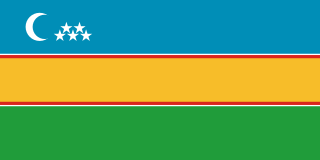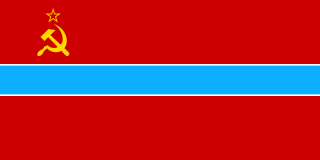
Karakalpakstan, officially the Republic of Karakalpakstan, is an autonomous republic of Uzbekistan. It occupies the whole northwestern part of Uzbekistan. The capital is Nukus. Karakalpakstan covers an area of 166,590 km2 (64,320 sq mi), and a population of about 2 million people. Its territory covers the classical land of Khwarezm, which in classical Persian literature was known as Kāt (کات).

The Uzbek Soviet Socialist Republic, also known as Soviet Uzbekistan, the Uzbek SSR, UzSSR, or simply Uzbekistan and rarely Uzbekia, was a union republic of the Soviet Union. It was governed by the Uzbek branch of the Soviet Communist Party, the legal political party, from 1925 until 1990. From 1990 to 1991, it was a sovereign part of the Soviet Union with its own legislation.

An Autonomous Soviet Socialist Republic was a type of administrative unit in the Soviet Union (USSR), created for certain ethnic groups to be the titular nations of. The ASSRs had a status lower than the constituent union republics of the USSR, but higher than the autonomous oblasts and the autonomous okrugs.
The flags of the Soviet Socialist Republics were all defaced versions of the flag of the Soviet Union, which featured a golden hammer and sickle and a gold-bordered red star on a red field.

The Turkestan Autonomous Soviet Socialist Republic was an autonomous republic of the Russian Soviet Federative Socialist Republic located in Soviet Central Asia. Uzbeks were the preeminent nation of Turkestan ASSR. Tashkent was the capital and largest city in the region.

The Khorezm People's Soviet Republic was the state created as the successor to the Khanate of Khiva in February 1920, when the Khan abdicated in response to pressure. It was officially declared by the First Khorezm Kurultay (Assembly) on 26 April 1920. On 20 October 1923, it was transformed into the Khorezm Socialist Soviet Republic.

The Karakalpak Autonomous Soviet Socialist Republic, also known as Soviet Karakalpakstan or simply Karakalpakstan, was an autonomous republic within the Soviet Union. Until 20 July 1932, it was called the Karakalpak Autonomous Oblast. On 5 December 1936, it was moved from the Russian SFSR to the Uzbek SSR. It was the only ASSR in Soviet Central Asia.
Autonomous oblasts of the Union of Soviet Socialist Republics were administrative units created for a number of smaller nations, which were given autonomy within the fifteen republics of the USSR.

The Mari Autonomous Soviet Socialist Republic was an autonomous republic of the Russian SFSR, succeeding the Mari Autonomous Oblast. When the Soviet Union disintegrated, the Mari ASSR became the Mari El Republic, a federal subject of the Russian Federation.

The Kazakh Autonomous Socialist Soviet Republic, abbreviated as Kazak ASSR and simply Kazakhstan, was an autonomous republic of the Russian Soviet Federative Socialist Republic (RSFSR) within the Soviet Union which existed from 1920 until 1936.

Soviet Central Asia was the part of Central Asia administered by the Soviet Union between 1918 and 1991, when the Central Asian republics declared independence. It is nearly synonymous with Russian Turkestan in the Russian Empire. Soviet Central Asia went through many territorial divisions before the current borders were created in the 1920s and 1930s.

The coat of arms of the Kazakh Soviet Socialist Republic was adopted on March 26, 1937, by the government of the Kazakh Soviet Socialist Republic. The coat of arms is based on the coat of arms of the Soviet Union.

The Mordovian Autonomous Soviet Socialist Republic was an autonomous republic of the Russian SFSR within the Soviet Union. It is now known as the Republic of Mordovia, a federal subject of Russia.

The Russian Soviet Federative Socialist Republic, previously known as the Russian Soviet Republic and the Russian Socialist Federative Soviet Republic, as well as being unofficially referred to as Soviet Russia, the Russian Federation, or simply Russia, was an independent federal socialist state from 1917 to 1922, and afterwards the largest and most populous Soviet socialist republic of the Soviet Union (USSR) from 1922 to 1991, until becoming a sovereign part of the Soviet Union with priority of Russian laws over Union-level legislation in 1990 and 1991, the last two years of the existence of the USSR. The Russian SFSR was composed of sixteen smaller constituent units of autonomous republics, five autonomous oblasts, ten autonomous okrugs, six krais and forty oblasts. Russians formed the largest ethnic group. The capital of the Russian SFSR and the USSR as a whole was Moscow and the other major urban centers included Leningrad, Stalingrad, Novosibirsk, Sverdlovsk, Gorky and Kuybyshev. It was the first Marxist–Leninist state in the world.

The Kabardino-Balkarian Autonomous Soviet Socialist Republic was an autonomous republic of the Russian Soviet Federative Socialist Republic within the Soviet Union, and was originally a part of the Mountain Autonomous Soviet Socialist Republic. On 16 January 1922 the region was detached from the Mountain ASSR and the Kabardino-Balkarian Autonomous Oblast on 1 September 1921. It became an autonomous republic on 5 December 1936. On 30 January 1991, the Kabardino-Balkarian ASSR declared state sovereignty. It is now the Kabardino-Balkaria republic, a federal subject of the Russian Federation. The Kabardino-Balkarian ASSR bordered no other sovereign states during the existence of the Soviet Union.

The Tajik Autonomous Soviet Socialist Republic was an autonomous republic within the Uzbek SSR in the Soviet Union. It was created in October 1924 by a series of legal acts that partitioned the three existing regional entities in Central Asia – Turkestan ASSR, Bukharan People's Soviet Republic, and Khorezm People's Soviet Republic – into five new entities based on ethnic principles: Uzbek SSR, Turkmen SSR, Tajik ASSR, Kara-Kirghiz Autonomous Oblast, and Karakalpak Autonomous Oblast.
The First Secretary of the Karakalpak regional branch of the Communist Party of the Soviet Union was the position of highest authority in the Karakalpak AO (1925–1932) in the Kazak ASSR and the Karakalpak ASSR (1932–1991) in the Russian SFSR of the Soviet Union. The position was created in October 1924, and abolished on September 14, 1991. The First Secretary was a de facto appointed position usually by the Politburo or the General Secretary himself.

The emblem of Karakalpakstan is one of the official symbols of republic Karakalpakstan within Uzbekistan. It was approved on April 9, 1993. The coat of arms was developed from a sketch by Karakalpak artist Jollybai Izentaev based on the emblem of Uzbekistan.

The flag the Yakut Autonomous Soviet Socialist Republic was adopted in 1954 by the government of the Yakut Autonomous Soviet Socialist Republic. The flag is identical to the flag of the Russian Soviet Federative Socialist Republic.

The flag of the Karakalpak Autonomous Soviet Socialist Republic was adopted in 1954 by the government of the Karakalpak Autonomous Soviet Socialist Republic. The flag is nearly identical to the flag of the Uzbek Soviet Socialist Republic. The former Karakalpak ASSR had its own flag from 1934 to its dissolution in 1992, which developed similarly to that of the Uzbek SSR. Basic design of the flag was always a red cloth with inscription.















